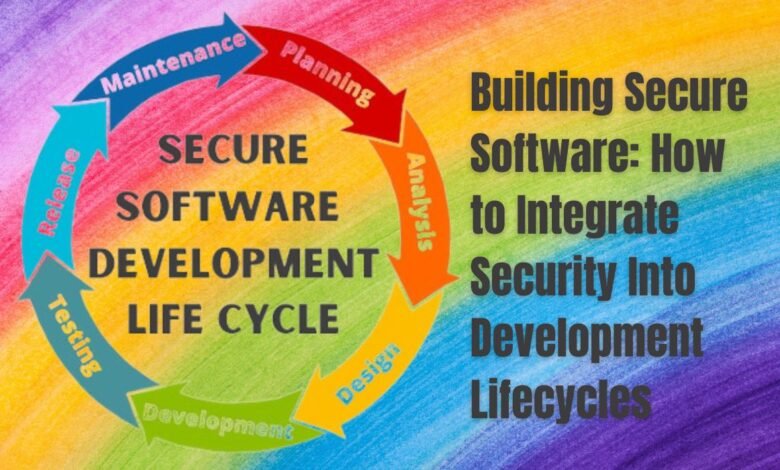Building Secure Software: How to Integrate Security Into Development Lifecycles
Building Secure Software: Learn how to integrate security into development lifecycles to ensure robust and safe applications.

In today’s rapidly evolving digital landscape, the concept of secure software development has become more critical than ever. The increasing frequency of cyber threats and data breaches poses significant risks to organizations of all sizes, making it imperative to prioritize security throughout the software development lifecycle (SDLC). Secure software development refers to the practice of integrating security measures from the earliest stages of the development process, rather than treating it as an afterthought.
With the proliferation of sophisticated cyberattacks, the potential consequences of neglecting security during development are severe. Data breaches can lead to substantial financial losses, damage to an organization’s reputation, and legal ramifications. Moreover, compromised software can expose sensitive data, disrupt business operations, and erode customer trust. Therefore, it is essential for developers and organizations to adopt a proactive approach to security, ensuring that robust security measures are embedded into every phase of the SDLC.
Integrating security from the beginning of the SDLC offers numerous benefits. Firstly, it helps protect sensitive data by identifying and mitigating vulnerabilities early in the development process. This proactive approach not only reduces the risk of exploitation but also minimizes the cost and effort required to address security issues later. Secondly, secure software development ensures compliance with industry regulations and standards, such as the General Data Protection Regulation (GDPR) and the Health Insurance Portability and Accountability Act (HIPAA). Adhering to these regulations is crucial for avoiding penalties and maintaining legal compliance.
Furthermore, building secure software fosters customer trust and confidence. In an era where data privacy is paramount, customers are increasingly concerned about how their information is handled and protected. Demonstrating a commitment to security through secure software development practices can enhance an organization’s reputation and attract more customers. Ultimately, integrating security into the development lifecycle is not just a technical necessity but also a strategic business imperative.
Key Principles of Secure Development
Building secure software necessitates adherence to fundamental principles that ensure security is woven into the fabric of the development lifecycle. These principles provide a robust foundation for creating resilient applications that can withstand potential threats. Below, we outline the key principles of secure development:
Security by Design: This principle emphasizes that security should be an integral part of the design process from the very beginning. By considering security at each phase of development, from initial planning to deployment, developers can create systems that are inherently secure. This proactive approach helps in identifying and mitigating vulnerabilities early, reducing the risk of security breaches.
Least Privilege: The principle of least privilege involves granting users and systems the minimum levels of access necessary to perform their functions. By limiting permissions, the potential damage from compromised accounts or systems can be minimized. This approach helps in preventing unauthorized access and reduces the attack surface.
Threat Modeling: Threat modeling is a systematic approach to identifying, evaluating, and addressing potential security threats. By anticipating possible attack vectors and understanding the potential impact, developers can implement appropriate countermeasures to mitigate risks. This process involves creating models to visualize and analyze threats, ensuring that security considerations are thoroughly integrated into the development lifecycle.
Code Reviews: Regular code reviews are essential for maintaining secure software. By having multiple developers examine the code, potential vulnerabilities can be identified and addressed early in the development process. Code reviews promote collaboration and knowledge sharing, leading to more robust and secure applications.
Static Analysis Tools: Using static analysis tools allows developers to automatically analyze code for security vulnerabilities without executing it. These tools can identify potential issues such as buffer overflows, injection flaws, and other common security vulnerabilities. Integrating static analysis into the development pipeline helps in catching security issues early, reducing the cost and effort required to fix them later.
By adhering to these key principles, development teams can create secure software that is resilient against a wide range of security threats. Integrating these practices into the development lifecycle ensures that security is not an afterthought but a fundamental aspect of software development.
Integrating Security into Each SDLC Phase
The Software Development Lifecycle (SDLC) consists of several key phases, each offering unique opportunities to integrate security measures. By embedding security practices throughout the SDLC, organizations can proactively address vulnerabilities and reduce risks.
Requirements Phase
In the ‘Requirements’ phase, it is crucial to define security requirements and compliance needs. This involves identifying potential security risks and regulatory obligations that the software must meet. Security requirements should be specific, measurable, and aligned with the organization’s overall security policies. Early identification of these requirements helps ensure that security considerations are not an afterthought but an integral part of the development process.
Design Phase
During the ‘Design’ phase, incorporating security architecture and threat modeling is essential. Security architecture involves designing the system with security controls in place, such as authentication, authorization, encryption, and logging mechanisms. Threat modeling helps identify potential threats and vulnerabilities in the system design, allowing for the implementation of mitigations before the software is developed. This proactive approach helps in building a robust and secure software foundation.
Implementation Phase
The ‘Implementation’ phase should emphasize secure coding practices and the use of automated security testing tools. Developers should adhere to coding standards and guidelines that promote security, such as avoiding common vulnerabilities like SQL injection and cross-site scripting (XSS). Automated tools can be used to scan code for security issues, ensuring that vulnerabilities are detected and addressed early in the development process. This helps in maintaining code quality and reducing the risk of security breaches.
Testing Phase
In the ‘Testing’ phase, the importance of penetration testing and vulnerability scanning cannot be overstated. Penetration testing involves simulating real-world attacks to identify security weaknesses, while vulnerability scanning helps detect known vulnerabilities in the software. These testing methods provide valuable insights into the security posture of the software and help in mitigating risks before deployment.
Deployment and Maintenance Phase
Finally, the ‘Deployment and Maintenance’ phase should focus on continuous monitoring, patch management, and incident response planning. Continuous monitoring involves keeping an eye on the software for any security anomalies and addressing them promptly. Patch management ensures that software updates are applied regularly to fix security vulnerabilities. Incident response planning prepares the organization to respond effectively to security incidents, minimizing damage and recovery time. These practices help in maintaining the security of the software throughout its lifecycle.
Best Practices and Tools for Secure Development
Integrating security into the software development lifecycle is crucial for producing robust and reliable applications. By adhering to best practices and utilizing specialized tools, developers can significantly reduce the risk of data breaches, ensure compliance with industry standards, and enhance the overall quality of their software. Below is a comprehensive list of best practices and tools that can help developers create more secure software:
Best Practices:
- Regular Security Training for Developers: Continuous education on the latest security trends, threats, and mitigation techniques ensures that developers are well-equipped to handle security challenges.
- Adopting a DevSecOps Approach: Integrating security practices into every phase of the development lifecycle, from planning to deployment, ensures that security is a fundamental aspect of the development process.
- Conducting Regular Security Audits: Regularly reviewing and auditing code for security vulnerabilities helps identify and address potential risks promptly.
- Implementing Secure Coding Standards: Adopting coding standards that emphasize security can help prevent common vulnerabilities such as SQL injection and cross-site scripting.
Tools:
- Static Analysis Tools: These tools analyze source code to detect potential security vulnerabilities before the code is executed. Examples include SonarQube and Fortify.
- Dynamic Analysis Tools: These tools test the running application to identify security vulnerabilities that may not be apparent in the source code. Examples include OWASP ZAP and Burp Suite.
- Dependency Checkers: Tools such as OWASP Dependency-Check scan project dependencies to identify known vulnerabilities in third-party libraries.
- Security Frameworks: Utilizing frameworks with built-in security features, such as Spring Security and OWASP ESAPI, can simplify the implementation of robust security measures.
By implementing these best practices and leveraging these tools, developers can create more secure software, ultimately leading to reduced risks of data breaches, improved compliance with regulatory requirements, and higher overall software quality.
- Top 10 AI Tools for Optimizing Your LinkedIn Networking
- Arzopa A1 Portable Monitor Review
- Microsoft And Google Chrome Users Targeted By Sophisticated Malware Campaign
Conclusion: Building Secure Software
Building secure software is an ongoing process that requires commitment and diligence. By integrating security into every phase of the SDLC, organizations can significantly reduce the risk of security incidents and protect their valuable data. Remember, security is not a one-time task but a continuous effort to stay ahead of potential threats.



